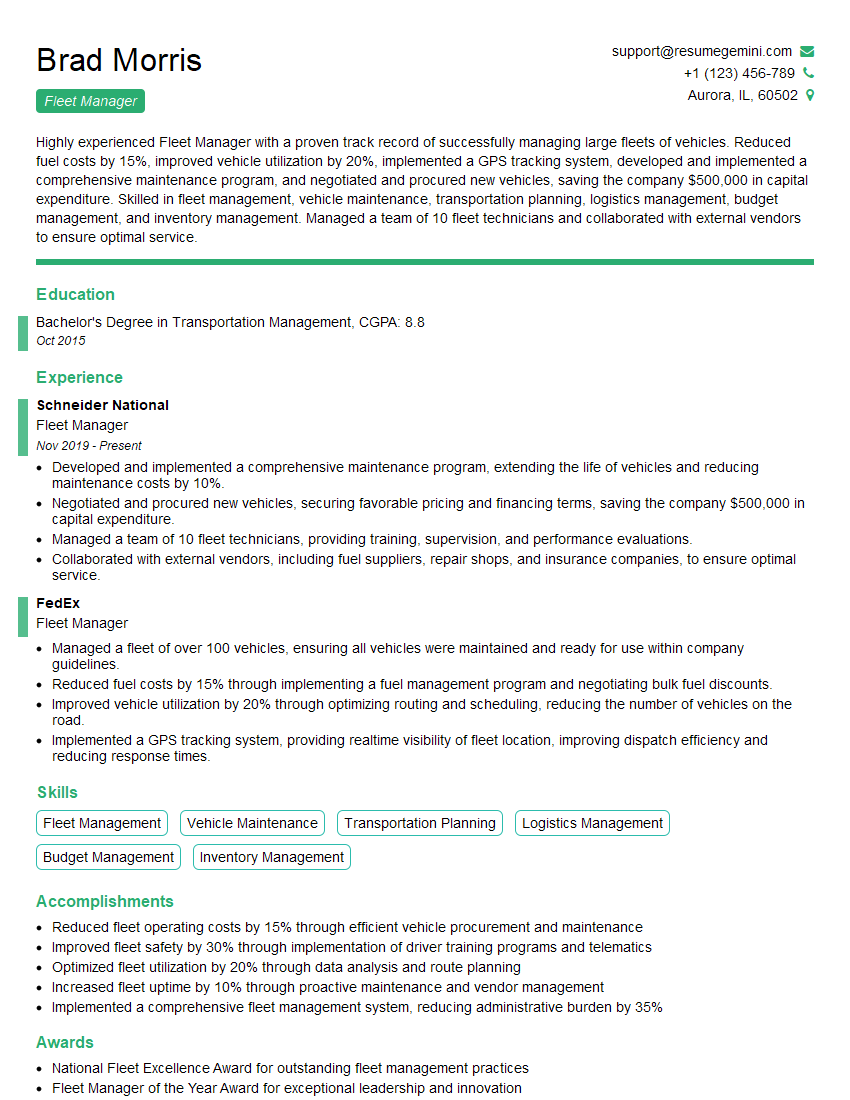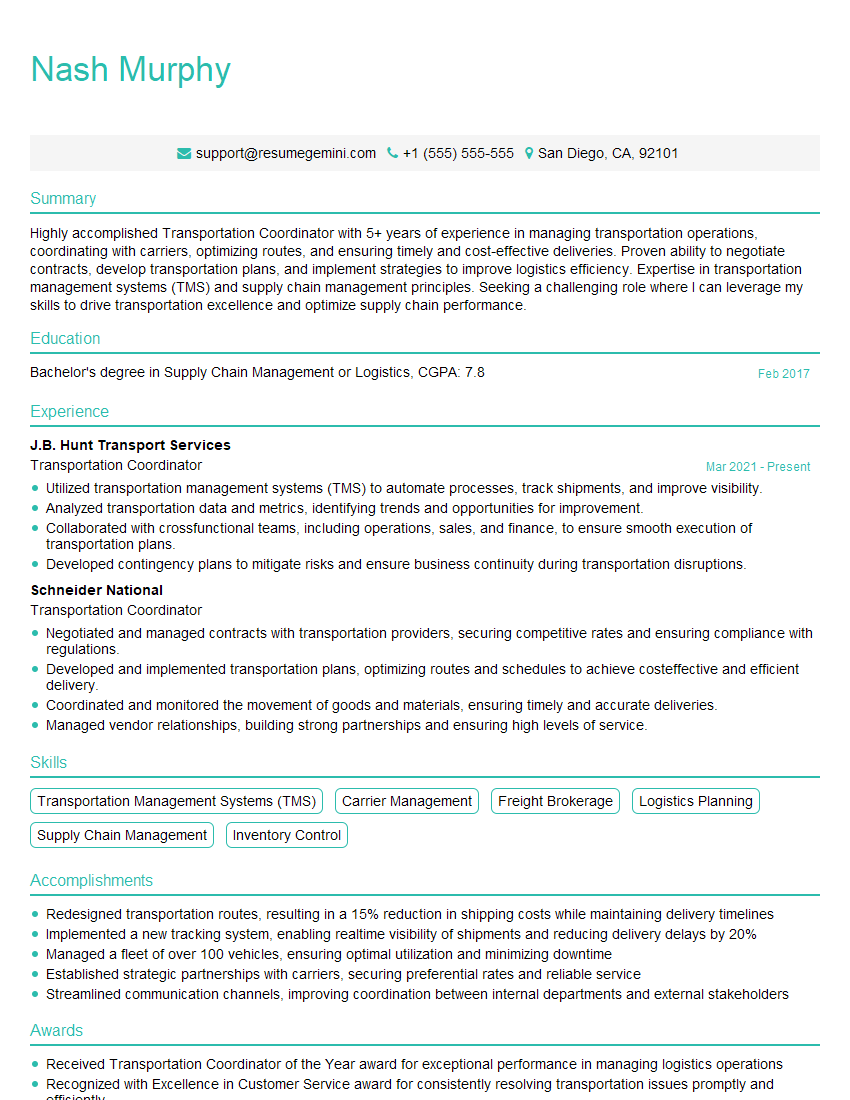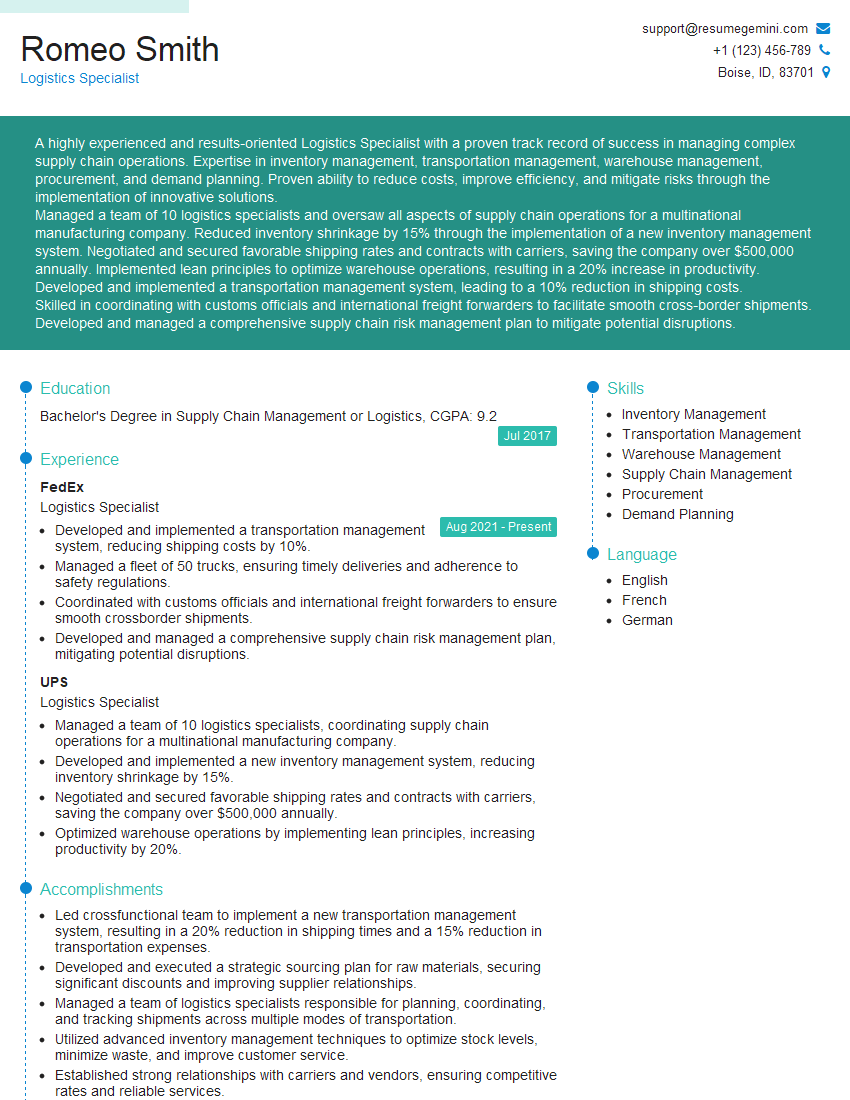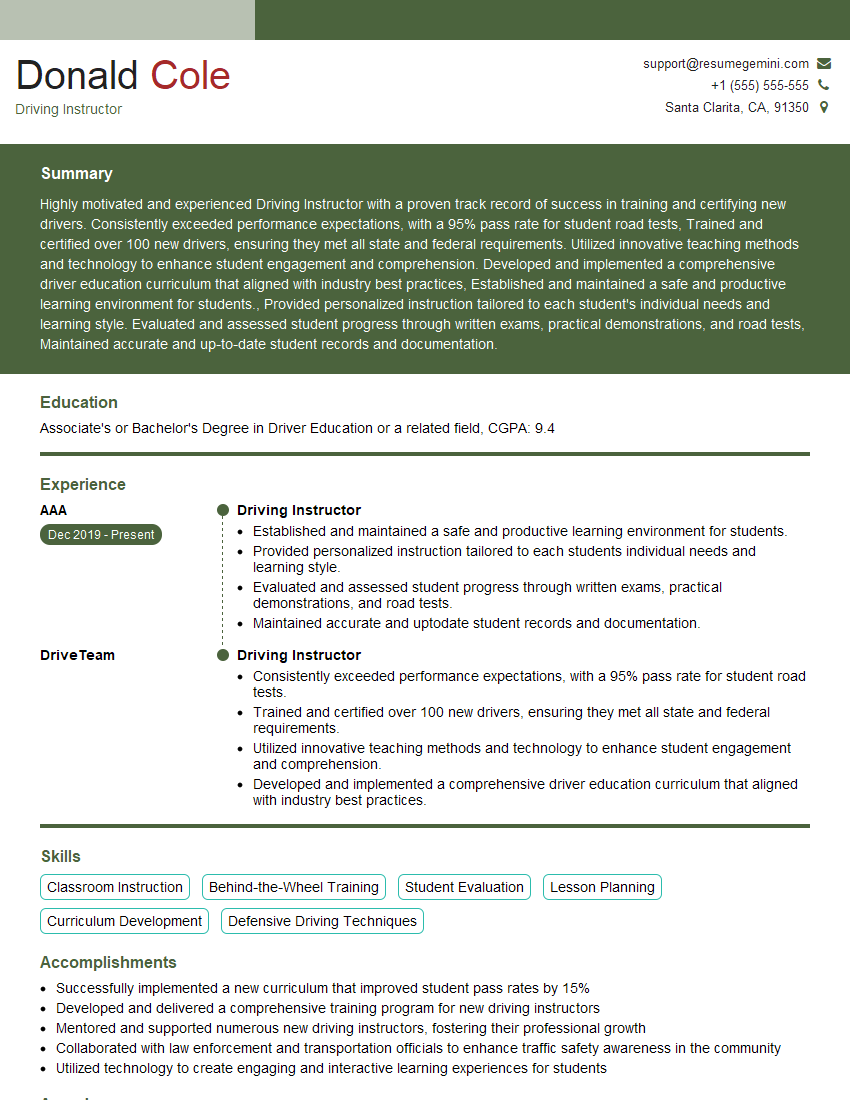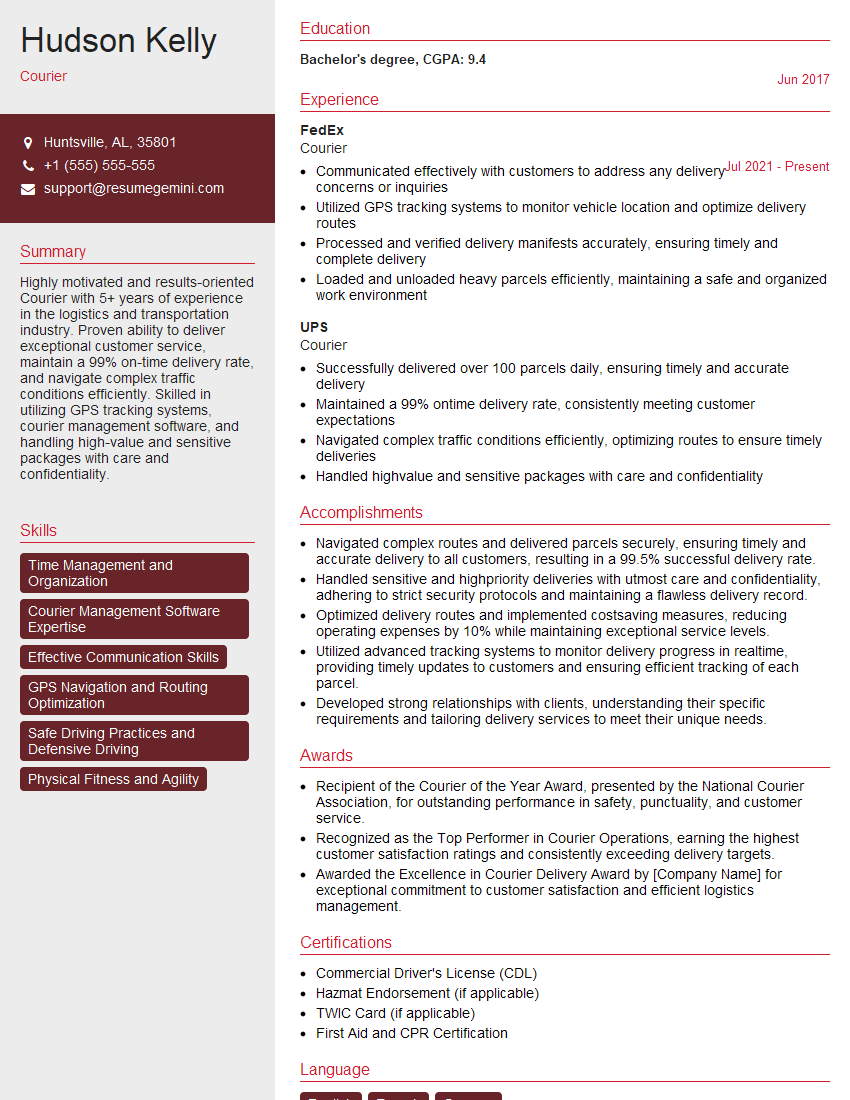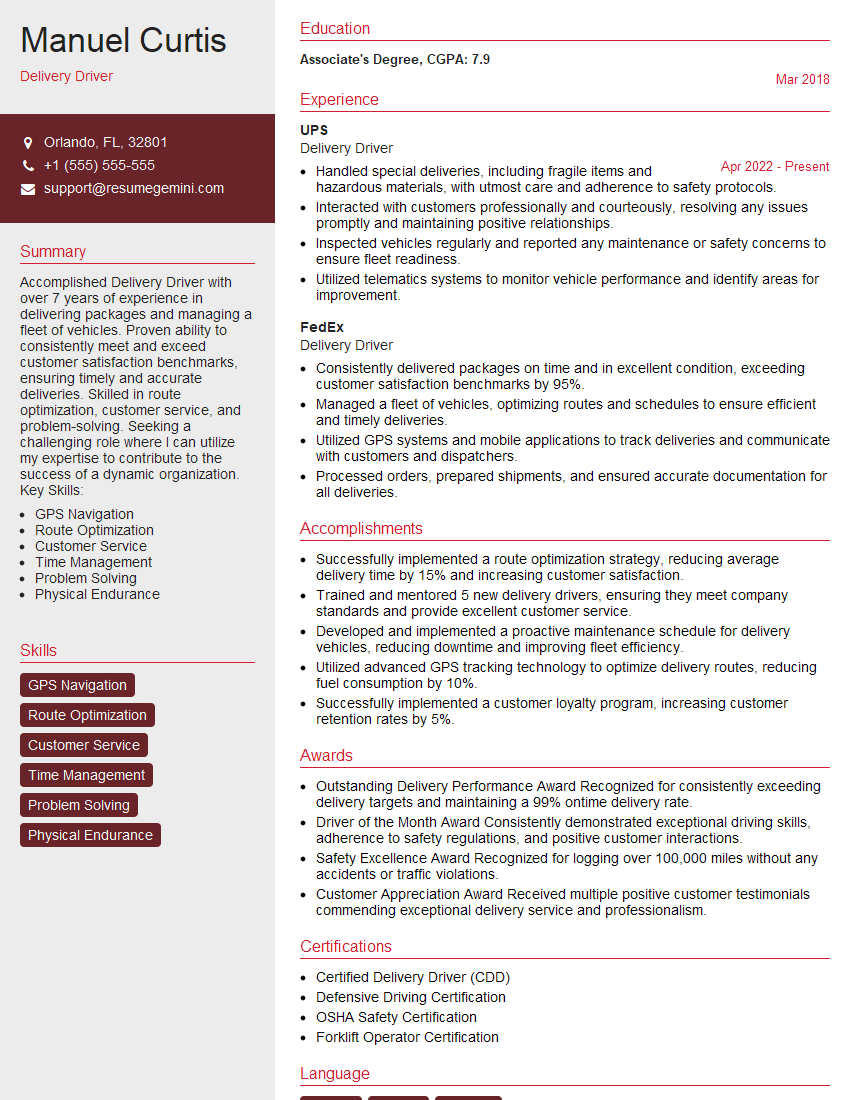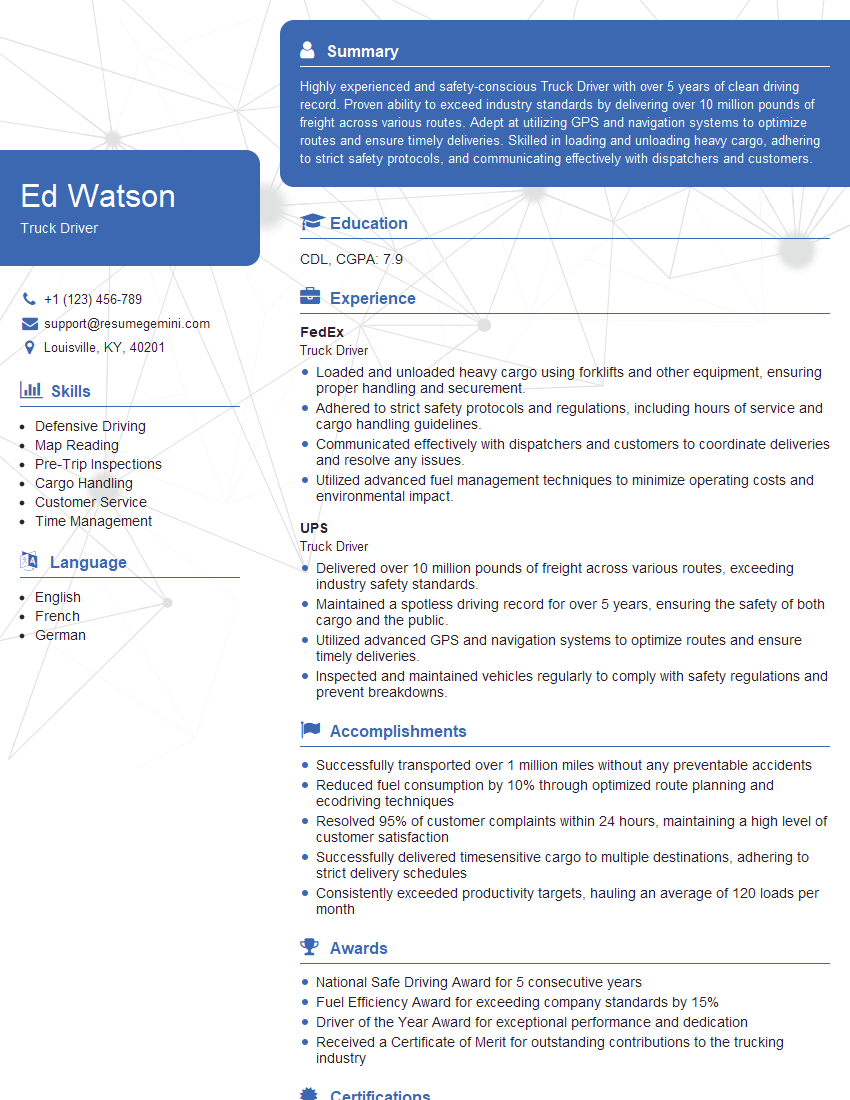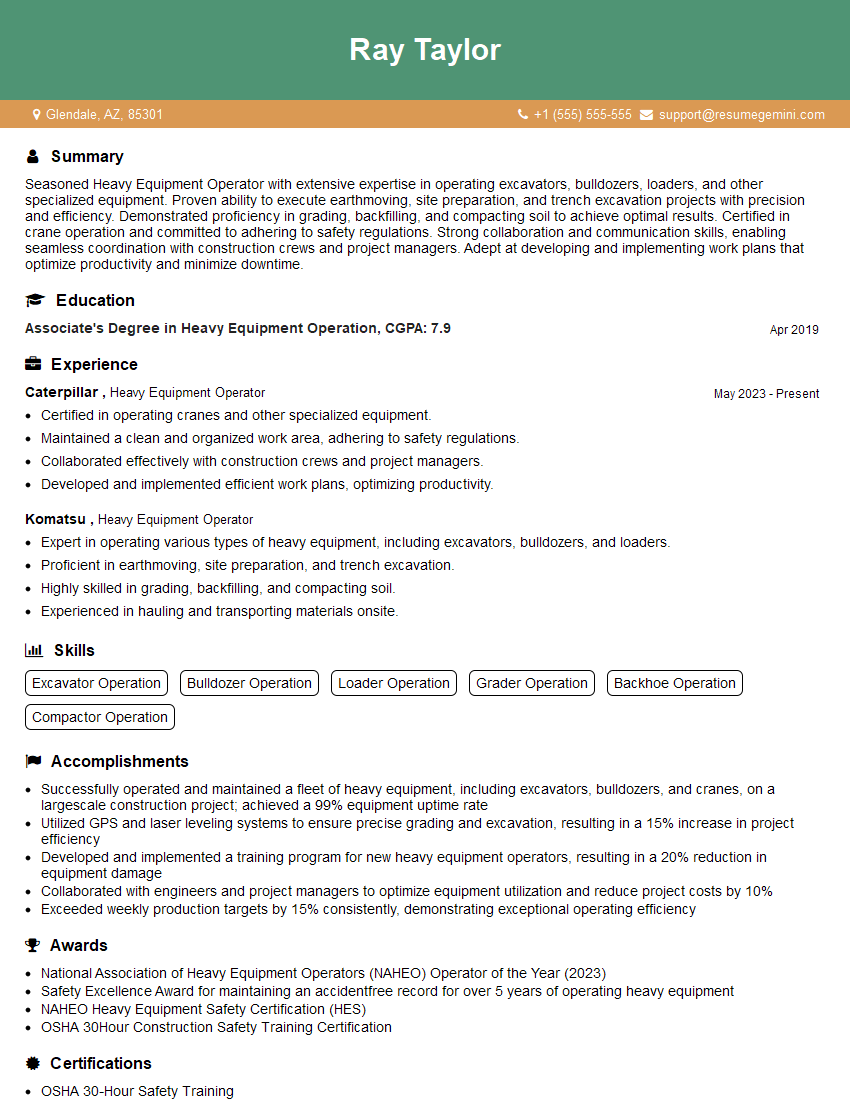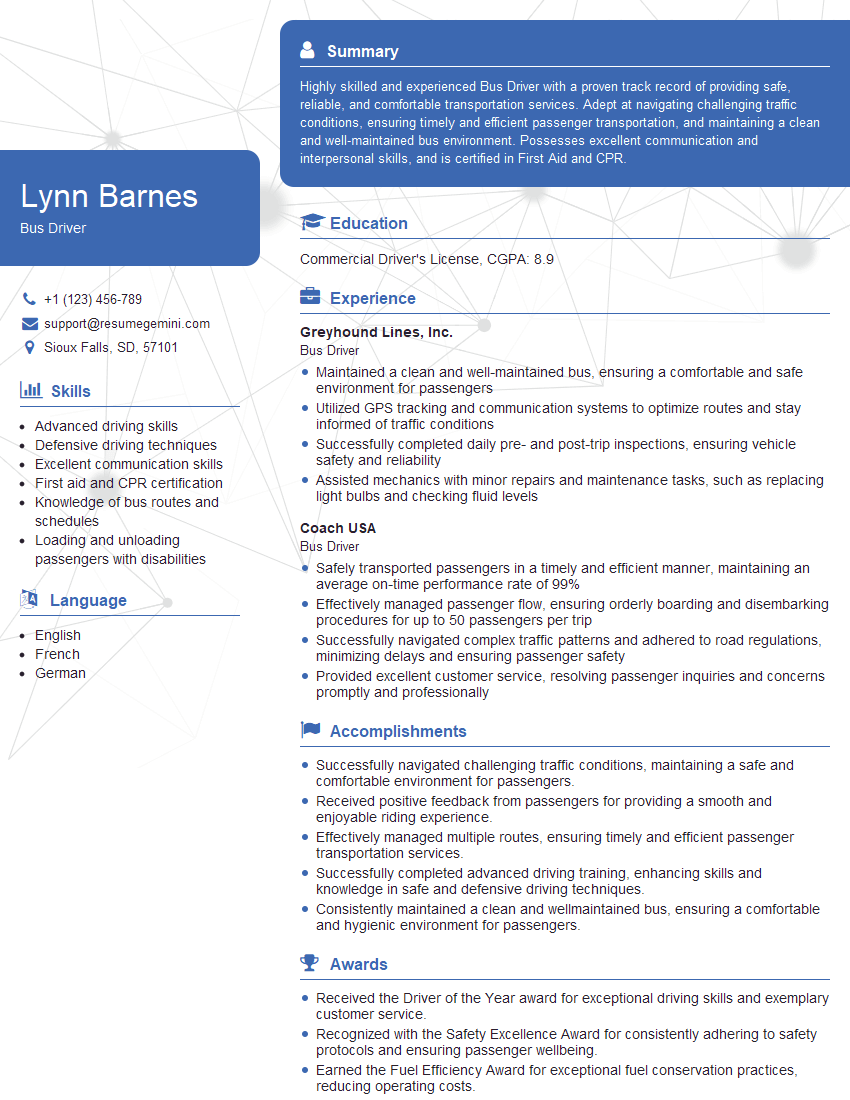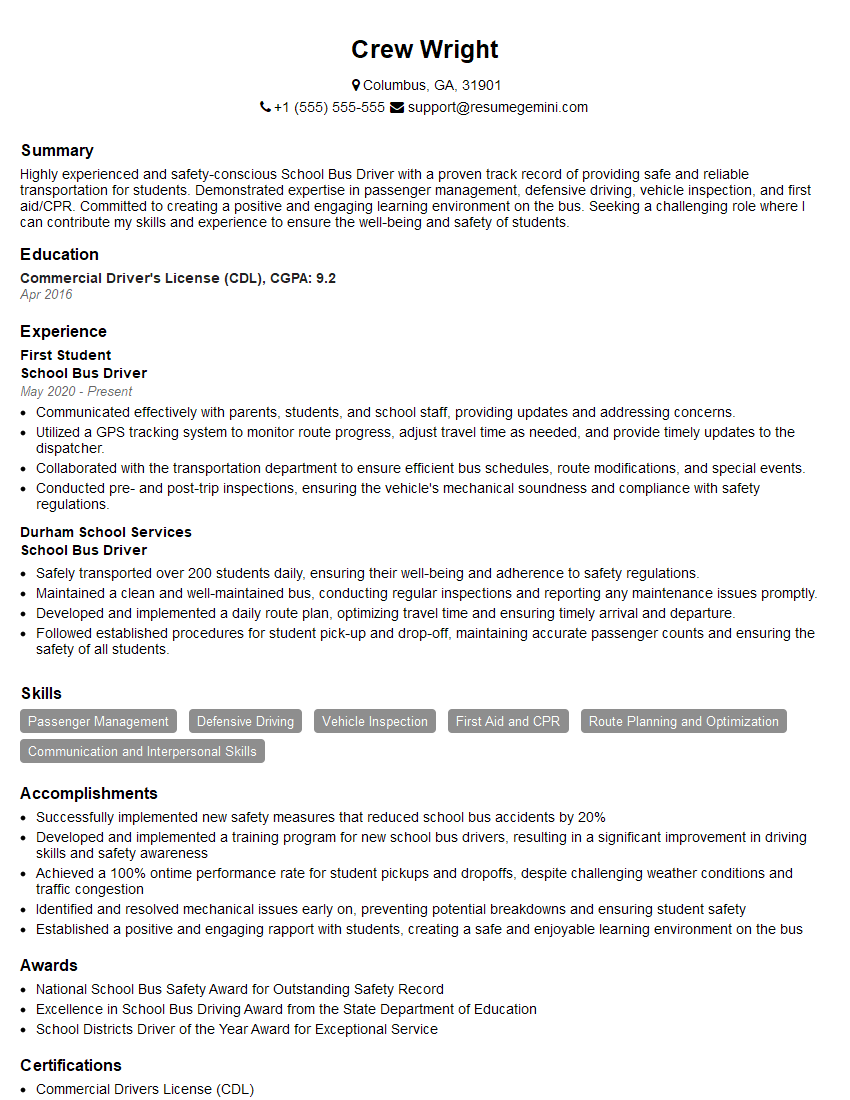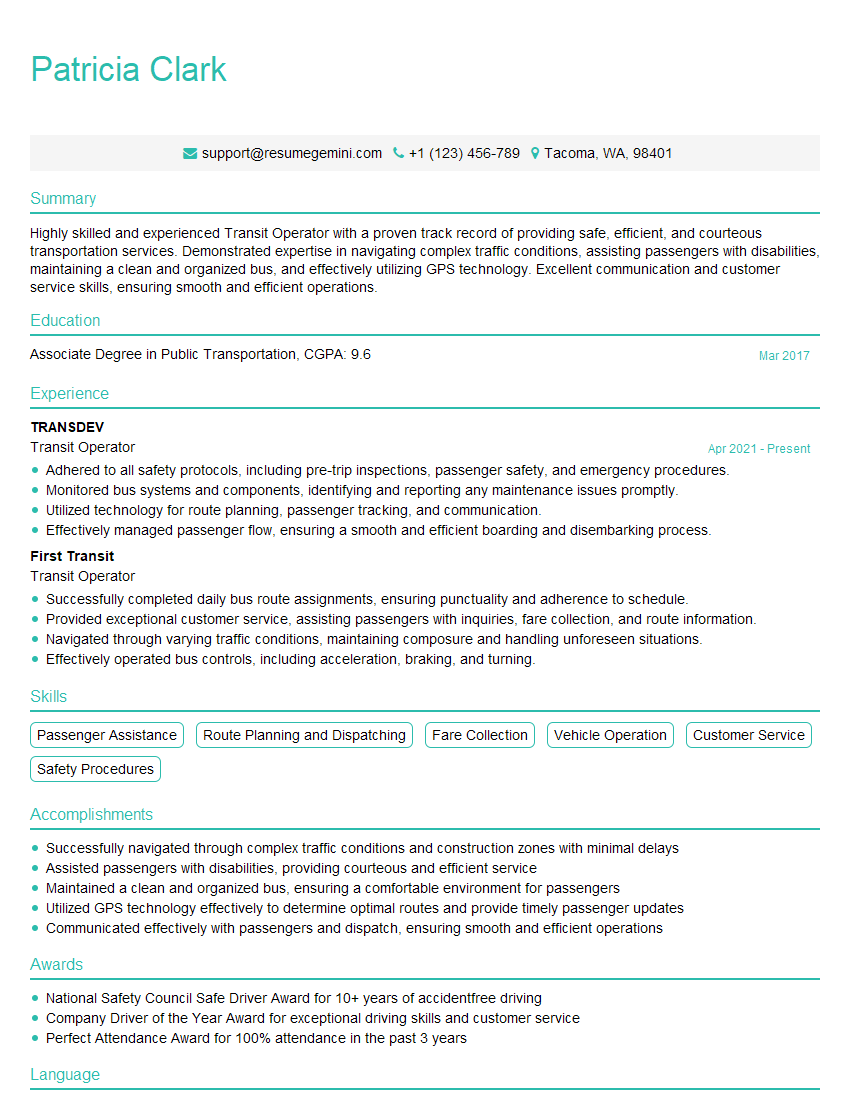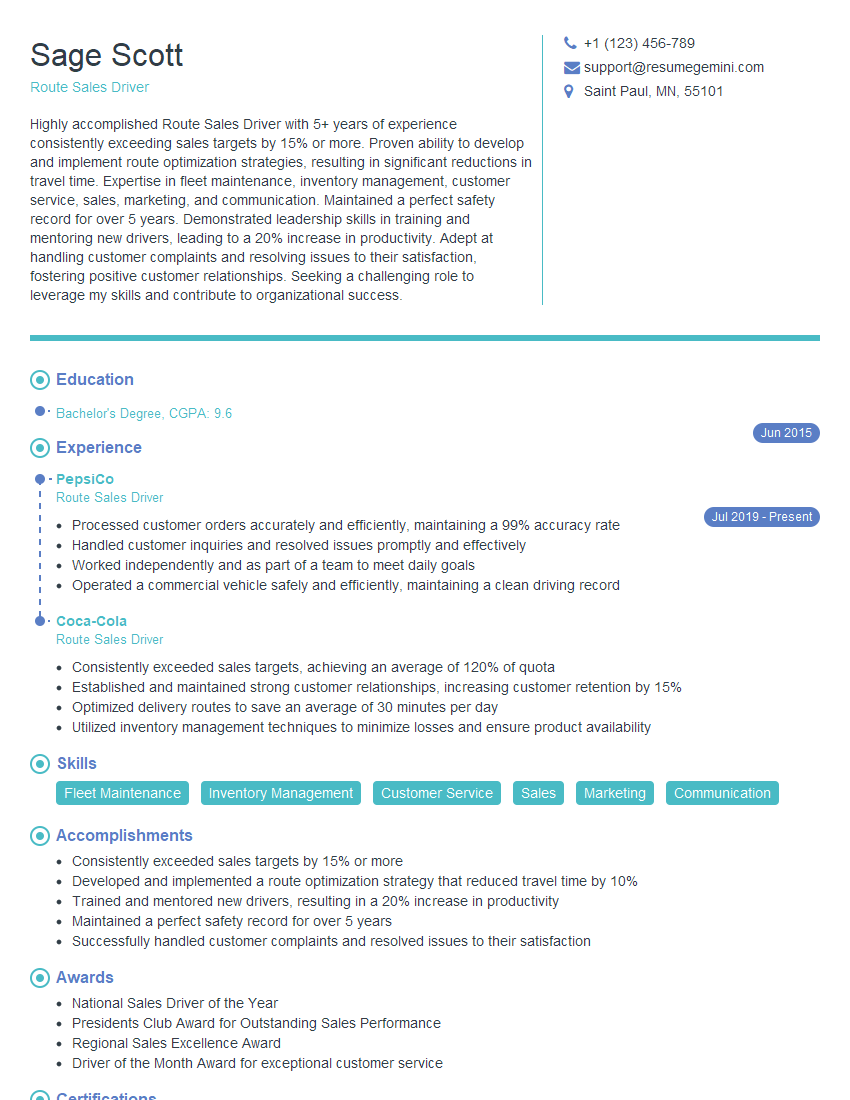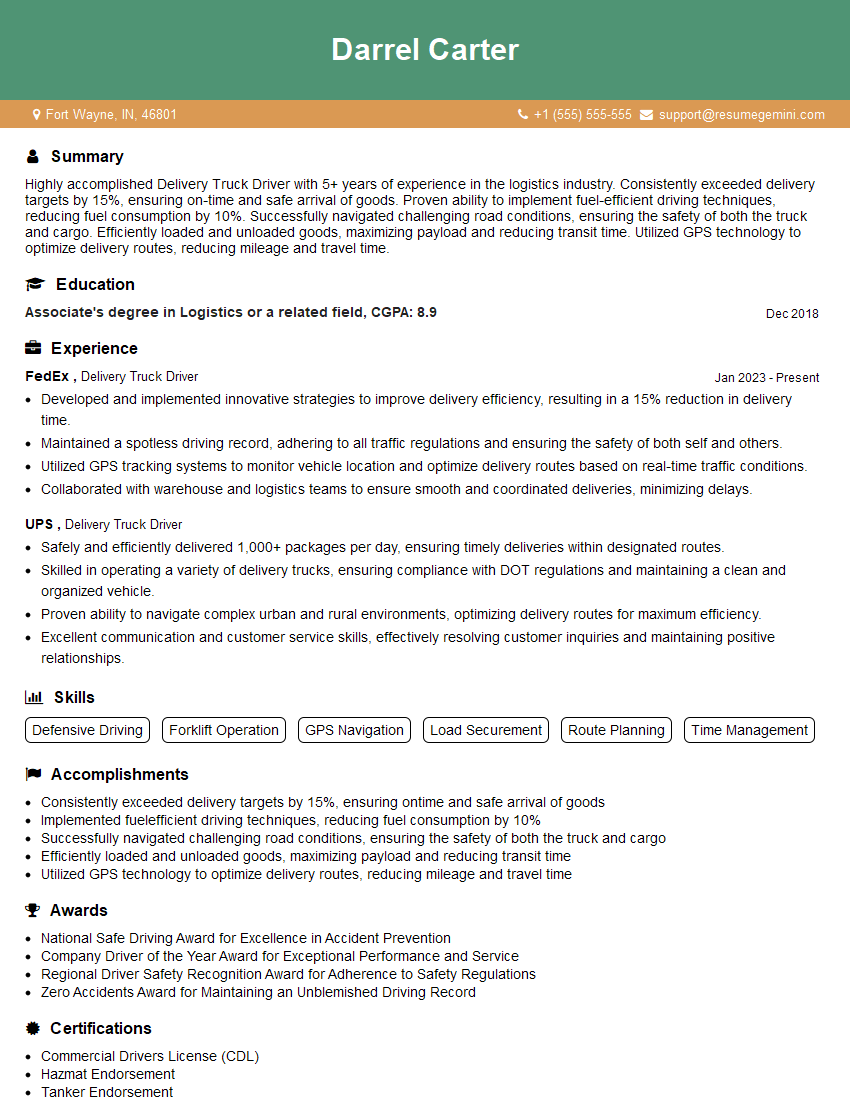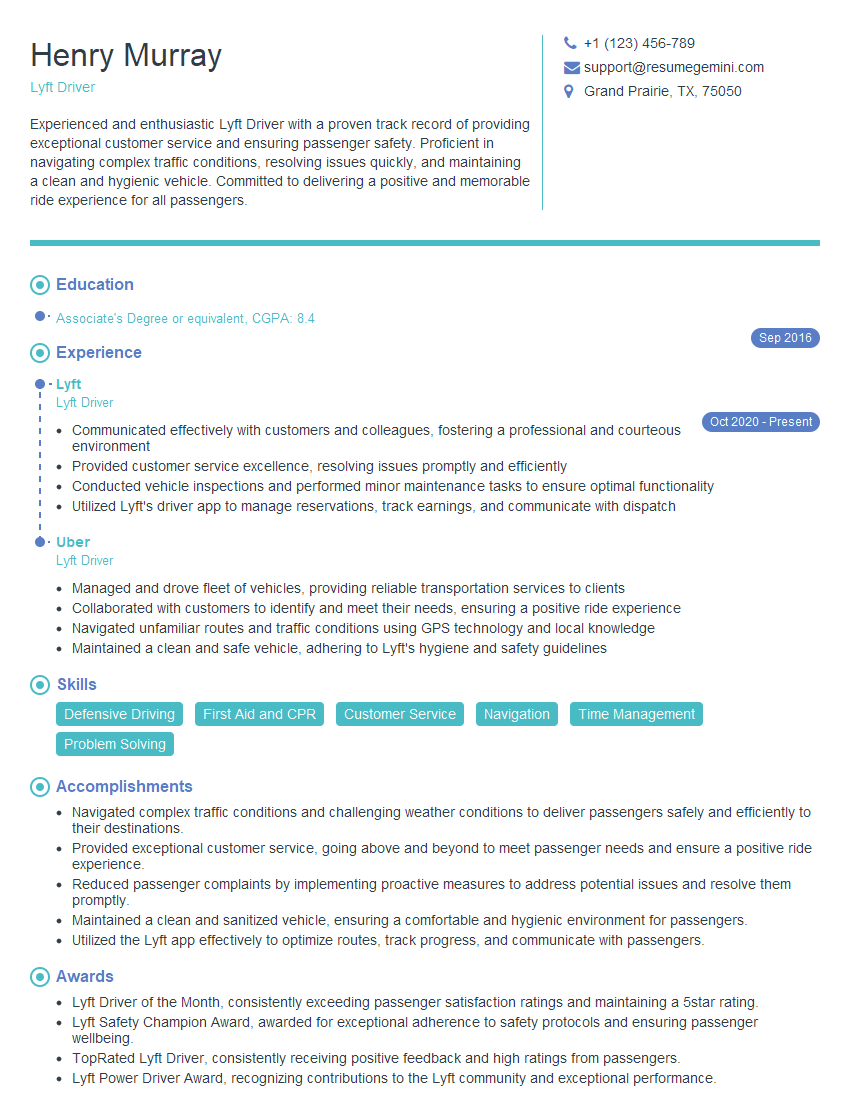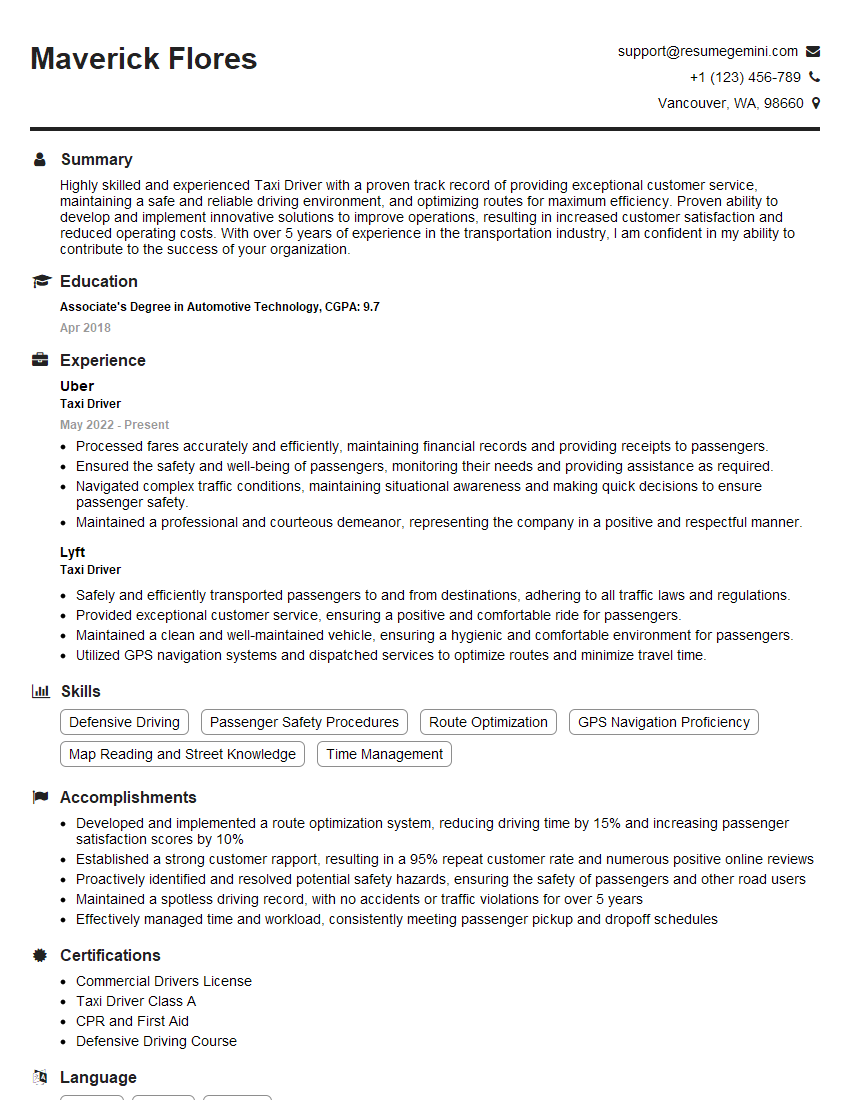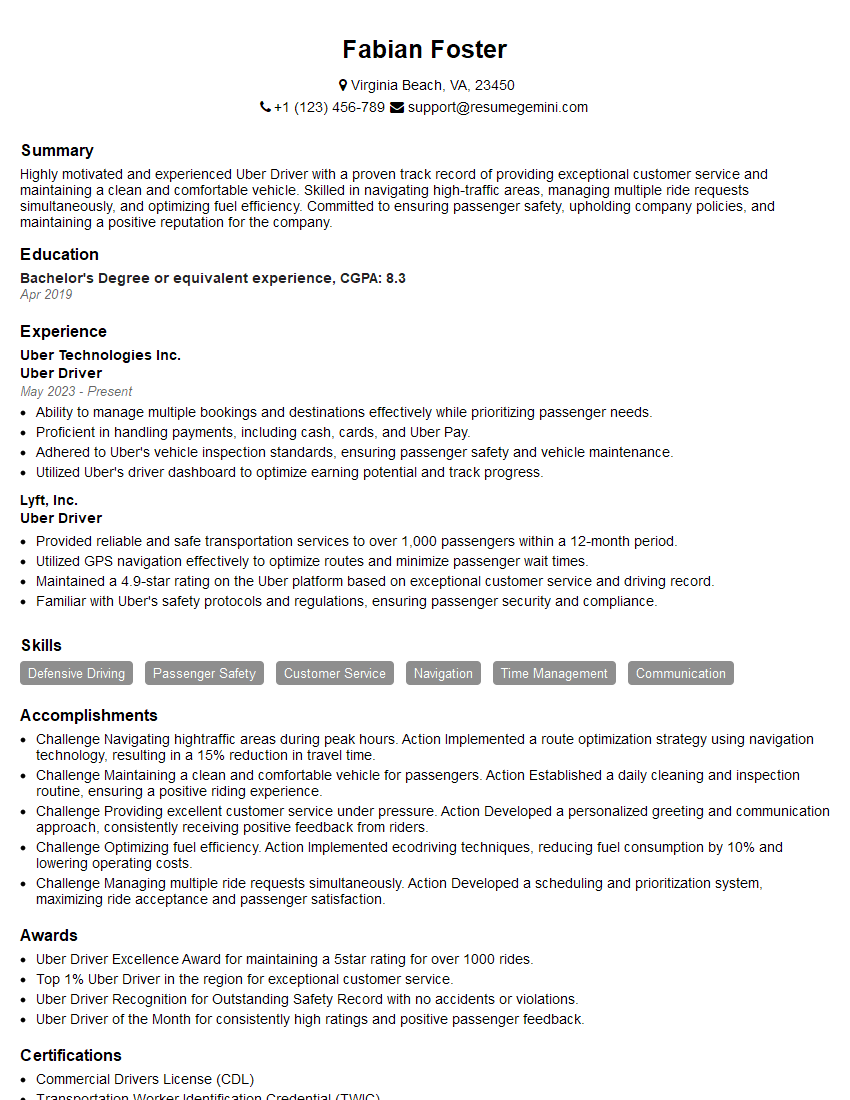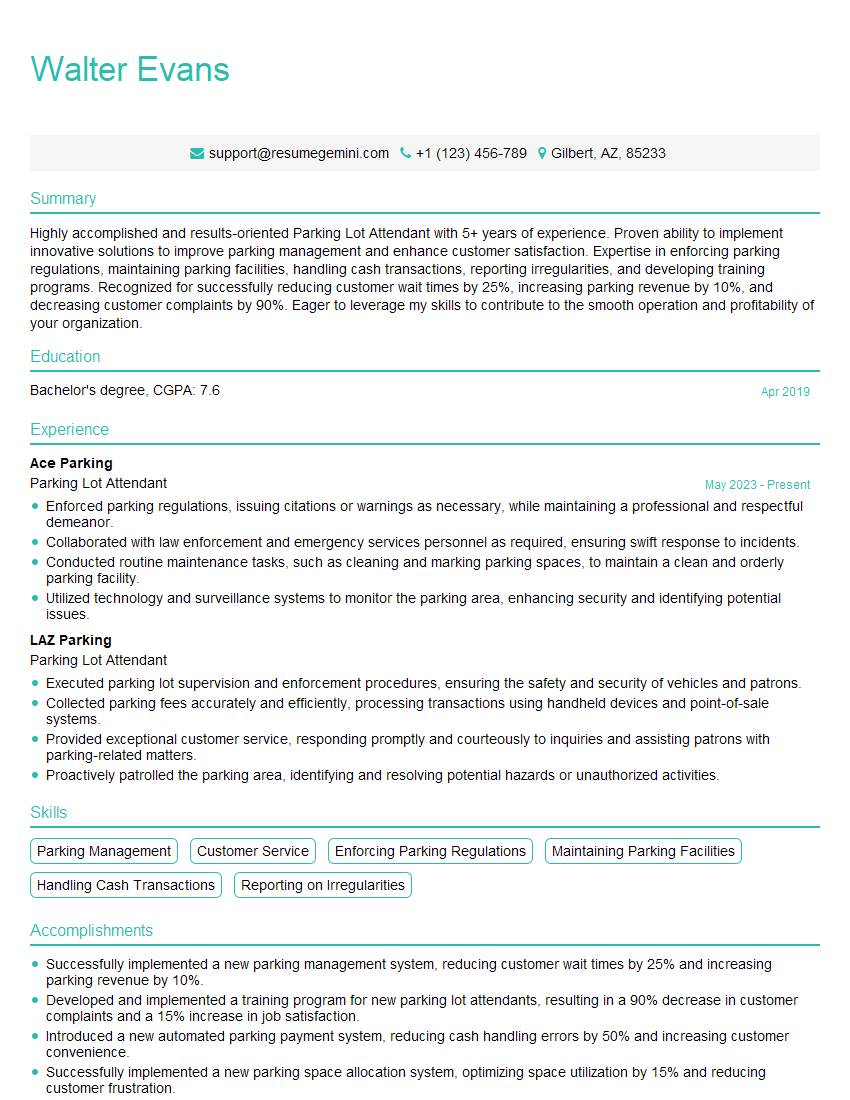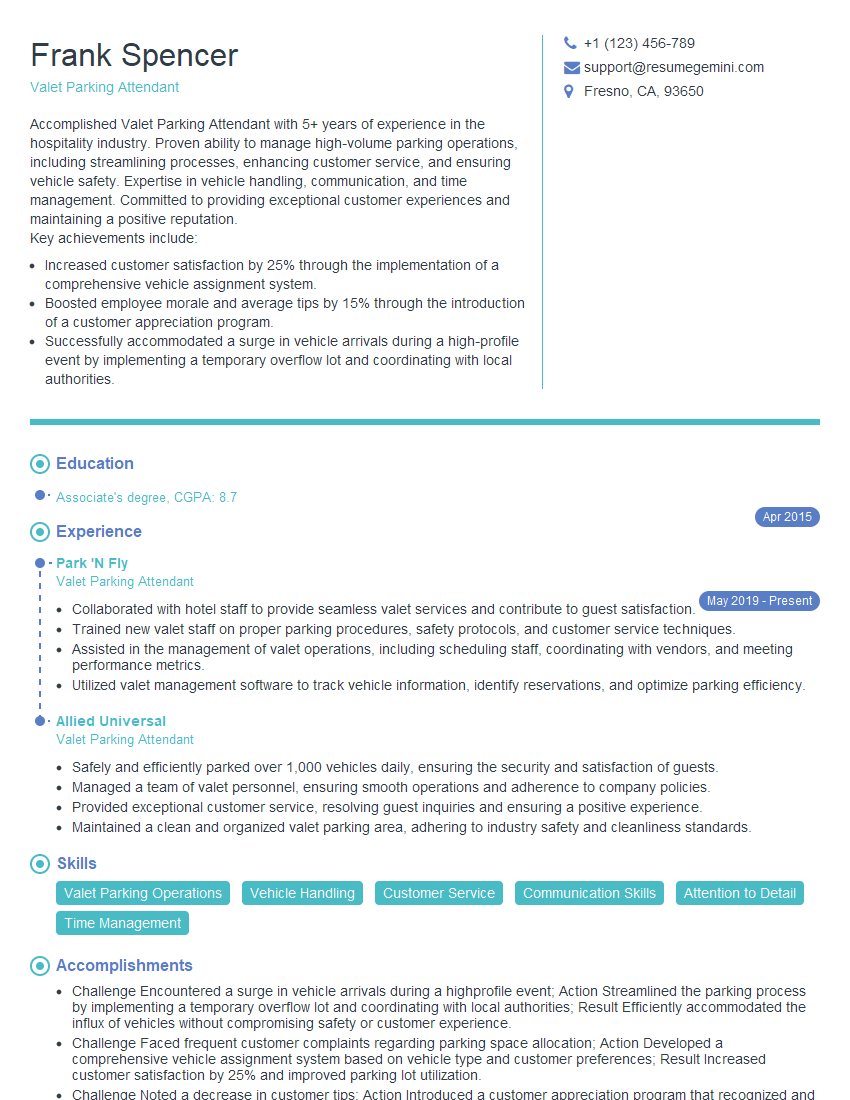Are you ready to stand out in your next interview? Understanding and preparing for Parallel Parking interview questions is a game-changer. In this blog, we’ve compiled key questions and expert advice to help you showcase your skills with confidence and precision. Let’s get started on your journey to acing the interview.
Questions Asked in Parallel Parking Interview
Q 1. Describe the ideal space for parallel parking.
The ideal space for parallel parking is approximately 1.5 times the length of your vehicle. This provides enough room to maneuver comfortably and avoid hitting the vehicles in front and behind. Anything less becomes increasingly challenging, and significantly less than that may be impossible without risking damage. Think of it like this: if your car is 15 feet long, you’ll need about 22.5 feet of space.
Factors like the angle of the space and the slope of the road can slightly alter this ideal length. A steeper slope can require a slightly longer space to compensate for the added difficulty of controlling your vehicle.
Q 2. What is the proper approach angle for parallel parking?
The proper approach angle for parallel parking is crucial. You shouldn’t approach the space head-on; instead, position your vehicle at approximately a 45-degree angle to the car in front of the empty space. This angle allows for a smoother, more controlled entry. Approaching too close or too far from the space will make the maneuver unnecessarily difficult.
Imagine you’re aiming to smoothly merge onto a highway; a slight angle makes the merge far easier than attempting it head-on. The same principle applies here. A too-sharp angle risks hitting the car in front. Too shallow and you’ll have to take the maneuver in steps, potentially creating more challenges.
Q 3. Explain the ‘three-point turn’ maneuver and when it’s appropriate.
A ‘three-point turn’ is a maneuver used to turn your vehicle around when you lack sufficient space to execute a simple U-turn. It involves three steps: pulling to the right side of the road, reversing to the left, and then moving forward to straighten out and finish the turn. It’s particularly useful in situations with limited visibility or restricted road space, such as narrow residential streets or parking lots with tight spaces.
- Step 1: Pull as far right as possible, ensuring you’re clear of traffic.
- Step 2: Reverse to the left across the road. Check all mirrors, and blind spots before beginning this step.
- Step 3: Once you have a clear view of traffic behind you, move forward straight to align yourself with the road.
It’s important to remember to only execute a three-point turn where it’s safe to do so – traffic laws and common courtesy for other road users dictate this. A three-point turn is not appropriate in high-traffic areas, busy intersections, or locations that might obstruct traffic flow.
Q 4. How do you judge the distance between your vehicle and other cars while parallel parking?
Judging distance is paramount in parallel parking. You should use a combination of your mirrors, your vehicle’s sensors (if equipped), and visual cues. Your side mirrors should allow you to see the edges of the surrounding cars. Start by positioning yourself parallel to the adjacent vehicle and use your mirrors to assess the gap. As you turn the steering wheel, use your mirrors to make adjustments as needed. Many modern vehicles have parking sensors that provide audible and visual warnings as you approach obstacles.
Remember, you’re not aiming for perfection on the first try. You can and should adjust your position even after partially completing the maneuver and continue to utilize your mirrors to check for obstacles. Even experienced drivers use a combination of these methods to make sure of their safety and to maneuver with precision.
Q 5. What are the common mistakes people make when parallel parking?
Common mistakes in parallel parking include approaching the space at the wrong angle, failing to check mirrors and blind spots adequately, turning the steering wheel too much or too little, not utilizing the entire available space, and not checking for obstacles, particularly pedestrians and cyclists. Many drivers also underestimate the turning radius of their vehicle.
- Incorrect Angle: Approaching head-on or at too shallow an angle makes it near impossible to fit comfortably.
- Inadequate Mirror Checks: This leads to collisions with other vehicles or obstacles.
- Over- or Under-steering: This results in either not being able to fit into the space or hitting the curb or other cars.
- Ignoring Available Space: Drivers sometimes make it harder for themselves by not backing up far enough to utilize the maximum available space.
Q 6. How do you handle parallel parking in a tight space?
Parallel parking in a tight space requires patience and precision. The key is to take your time and make small, controlled adjustments using the mirrors. Before starting, it is important to note the size of your vehicle and the limited space available. It might be beneficial to take a deep breath and make a mental plan before starting the maneuver. In extreme cases, you might consider finding an alternate parking spot to avoid potential damage or stress. It is better to find a better location than to force a maneuver that is too tight and dangerous.
Practicing in a safe, open area can build confidence and improve your ability to judge distances and control your car. The more you practice, the more comfortable you’ll become, allowing you to manage even the most challenging parallel parking situations.
Q 7. Describe your method for checking your surroundings before parallel parking.
Checking your surroundings before parallel parking is crucial for safety. I always begin by activating my turn signal to indicate my intention. I then conduct a thorough visual check, utilizing my mirrors and looking over my shoulder to ensure there are no pedestrians, cyclists, or other vehicles approaching. I also assess the space itself, noting the angle and the distance to the vehicles in front and behind. The position of any obstacles such as pillars, signage, or protruding objects will be noted. I always check for potential hazards, such as potholes or uneven surfaces, in the area where the maneuver will take place. Only after this comprehensive check do I proceed.
This is essential because it prevents accidents, reduces stress, and makes the parking process safer and easier. It’s better to take an extra few seconds to ensure safety than to risk a collision. Think of this as part of the process – a complete check up before surgery (in this case, your maneuver).
Q 8. How do you use your mirrors effectively during parallel parking?
Effective mirror usage is paramount in parallel parking. Think of your mirrors as extensions of your eyes, providing a panoramic view of your surroundings. Before you even begin, adjust your mirrors to minimize blind spots. This means using the convex (wide-angle) mirrors to see as much of the lane beside and behind you as possible. During the maneuver, constantly check your mirrors. Your driver’s side mirror will be most crucial for judging the distance between your vehicle and the car in front, ensuring you’re not too close or too far. The passenger side mirror helps you gauge your position relative to the car behind you and the curb. Regular glances at both mirrors, in conjunction with looking over your shoulder (always check your blind spot!), allow for precise control and avoid collisions.
Example: Imagine you’re backing into a space. As you reverse, consistently check your driver’s side mirror to maintain a safe distance from the vehicle ahead. If that car starts to appear larger in your mirror, it means you’re getting too close, and you need to gently steer away and adjust.
Q 9. How do you adjust your speed and steering to control your vehicle during parallel parking?
Speed and steering control are intertwined. The key is to be slow and deliberate, never jerky. Think of parallel parking as a dance, requiring smooth, coordinated movements. Start by approaching the space slowly, maintaining a steady speed that allows you to react to changes. Your steering should be equally gentle. Avoid making large, abrupt turns, as this can make the vehicle difficult to control. Small, incremental adjustments are more effective. As you reverse, small steering corrections should guide you into the space, correcting your alignment as necessary. Once you’re almost in place, subtle steering can fine-tune your positioning.
Example: Imagine you’re reversing and the rear of your car starts to drift away from the curb. Instead of yanking the wheel, make a small correction by turning the steering wheel gently towards the curb. Observe how your car responds to the adjustment in the mirrors and continue with gentle corrections until perfectly aligned.
Q 10. How do you manage parallel parking on hills or inclines?
Parking on hills requires extra caution. Before starting, ensure your parking brake is firmly engaged. This prevents your vehicle from rolling. The method is largely the same as on level ground, but with added awareness of the slope. If parking uphill with a curb, turn your wheels away from the curb (towards the downslope). This prevents rolling if your brakes fail. If parking uphill without a curb, turn your wheels towards the curb. If parking downhill, always turn your wheels towards the curb, preventing the vehicle from rolling into traffic. Your approach and speed should be even slower to compensate for the slope. Extra attention should be paid to the mirrors and surroundings for better control.
Example: On an uphill parking space with a curb, I’d carefully reverse into the spot, engage the parking brake once I’m in position, and then turn my wheels towards the down-slope. This ensures that even if the parking brake slips, my car will roll away from traffic and not down into the street.
Q 11. What do you do if you fail the first attempt at parallel parking?
Failing the first attempt at parallel parking is perfectly normal, especially for beginners or in tight spaces. Don’t get discouraged! Pull forward out of the space, and assess the situation. Check for any obstacles or traffic, then reposition your car for another attempt. Take a moment to adjust your approach. Maybe you need to start further back, or approach the space at a slightly different angle. Remember, practice makes perfect, and each unsuccessful attempt offers a learning opportunity. Carefully review your actions from the failed attempt, analyzing where you might have gone wrong.
Example: If I fail the first try because I’m too close to the car in front, I’d pull out completely, position my car further back and try again, aiming to leave a bigger gap. Constant self-evaluation is key.
Q 12. What is the importance of checking blind spots before and after parallel parking?
Checking blind spots before and after parallel parking is crucial for safety. Before starting, always check your mirrors and look over your shoulder to ensure no pedestrians or vehicles are approaching. After completing the maneuver, repeat this process to make sure you’re not blocking traffic or obstructing other drivers’ paths. Blind spot checks are a habit that should always be maintained, not just during parallel parking, but every time you are merging, turning, or changing lanes.
Example: Before backing into a space, I always perform a head-check towards my blind spot on the passenger side to ensure nothing is approaching. After parking, a quick mirror check and a shoulder check are done before opening my door to confirm safety.
Q 13. How do different vehicle types influence your parallel parking technique?
Different vehicle types require adjustments to the parallel parking technique. Larger vehicles, such as SUVs or trucks, need more space and wider turning radii. Smaller vehicles, like compact cars, offer better maneuverability but may need more precise adjustments. The length of your car will drastically influence your approach and how much space you will need. Long vehicles require more distance to begin with. Learning your vehicle’s dimensions and turning radius is key to success. Practice with your own car to build your spatial awareness.
Example: Parking a large SUV requires me to start much further back from the target space and use wider turns to maneuver into the spot, compared to a smaller car which requires a smaller space and tighter movements.
Q 14. How do you adapt your parallel parking strategy for varying road conditions (e.g., ice, snow)?
Adverse road conditions like ice or snow significantly impact parallel parking. Reduced traction means you need to proceed even more slowly and gently. Increase your following distance and make sure you are allowing for more time and space to perform the maneuver. Use extra caution when steering, as sudden movements may lead to skidding. Consider using a lower gear to help control your speed, especially in snowy or icy conditions. If conditions are extremely hazardous, consider avoiding parallel parking altogether and opting for an easier parking spot.
Example: In icy conditions, I would approach the parking space at a significantly slower speed, making very gradual steering corrections to avoid losing control. I might also choose a larger space to provide extra margin for error.
Q 15. Explain the difference between a ‘pull-in’ and a ‘back-in’ parallel parking method.
The core difference between ‘pull-in’ and ‘back-in’ parallel parking lies in the approach. ‘Back-in’ parking, the more common method, involves reversing into the space. ‘Pull-in’ parking, less frequently used, requires pulling forward into the space after initially positioning your vehicle alongside it.
Think of it like this: back-in is like carefully backing into a garage, whereas pull-in is like pulling into a driveway that’s already partially accessible.
Career Expert Tips:
- Ace those interviews! Prepare effectively by reviewing the Top 50 Most Common Interview Questions on ResumeGemini.
- Navigate your job search with confidence! Explore a wide range of Career Tips on ResumeGemini. Learn about common challenges and recommendations to overcome them.
- Craft the perfect resume! Master the Art of Resume Writing with ResumeGemini’s guide. Showcase your unique qualifications and achievements effectively.
- Don’t miss out on holiday savings! Build your dream resume with ResumeGemini’s ATS optimized templates.
Q 16. When is it appropriate to utilize a ‘pull-in’ parallel parking method?
A ‘pull-in’ parallel parking method is appropriate in specific situations. Primarily, it’s useful when:
- The space is exceptionally wide, allowing enough room to pull in without significant maneuvering.
- There’s limited visibility behind the vehicle, making reversing potentially risky. This is often the case on busy streets with high pedestrian or traffic flow.
- The angle of approach to the parking space is extremely acute, making a standard back-in approach challenging.
However, it’s important to note that the ‘pull-in’ method is less efficient and requires more space than the ‘back-in’ method, making it less practical in most scenarios.
Q 17. Describe a situation where you had difficulty parallel parking and how you resolved it.
I once encountered a particularly tight parallel parking space on a steeply inclined hill. The space was barely longer than my car, and the incline made judging distances difficult. My initial attempts resulted in me being too close to the car in front and unable to straighten out the vehicle.
To resolve this, I opted for a multi-step approach. I first pulled forward slightly to gain a better angle and re-assessed the space. I then used small, controlled movements of the steering wheel and the gas/brake pedals while constantly checking my mirrors and surroundings. Multiple forward-and-backward adjustments were required to perfectly align my vehicle. Ultimately, patience and careful observation were key to successfully navigating this tricky space.
Q 18. What safety measures do you prioritize while parallel parking?
Safety is paramount during parallel parking. My priorities include:
- Checking mirrors and blind spots thoroughly before initiating any maneuver.
- Using turn signals to communicate intentions to other drivers and pedestrians.
- Proceeding slowly and cautiously, making small adjustments rather than large, jerky movements.
- Maintaining awareness of surroundings, including pedestrians, cyclists, and other vehicles.
- Avoiding distractions, such as mobile phones or passengers.
In challenging situations, I might also choose to ask for assistance from a spotter or utilize parking sensors/cameras if available.
Q 19. How do you assess the risk of potential collisions during parallel parking?
Assessing the risk of collision involves a thorough pre-maneuver evaluation. I consider:
- Space availability: Is there enough room for safe maneuvering? This includes checking the distance to the cars in front and behind, as well as the width of the space.
- Surrounding traffic and pedestrians: How busy is the street? Are there any obstructions or hazards nearby?
- Visibility: Is my view unobstructed? Are there any blind spots that could hinder my ability to safely navigate the space?
- Environmental factors: Is the surface level and even? Are there any weather conditions that could affect traction or visibility?
By systematically assessing these factors, I can determine the level of risk and adjust my approach accordingly.
Q 20. How would you instruct a novice driver on the steps of parallel parking?
Teaching a novice driver parallel parking involves a structured approach:
- Find a suitable space: Explain the importance of choosing a space sufficiently long and wide for their vehicle.
- Position the car: Show how to position the vehicle parallel and slightly beyond the car in front of the empty space.
- Begin backing up: Demonstrate how to slowly back up, turning the steering wheel fully towards the curb or sidewalk.
- Straighten the wheel: Explain when to straighten the steering wheel once the vehicle is at a suitable angle.
- Adjust as needed: Emphasize the need for small adjustments to center the vehicle in the parking space.
- Practice makes perfect: Encourage repeated practice in a safe environment, such as an empty parking lot.
Throughout the process, emphasize the importance of checking mirrors, signaling, and proceeding cautiously.
Q 21. What is your preferred method for parallel parking?
My preferred method is the ‘back-in’ parallel parking technique. While requiring more skill initially, it’s generally more efficient and safer than the ‘pull-in’ method. It allows for better visibility and control during the maneuver, reducing the risk of collisions.
Q 22. How do you react to other drivers who might impede your parallel parking maneuver?
Patience and observation are key when dealing with other drivers who might impede my parallel parking maneuver. I wouldn’t honk or make aggressive gestures; instead, I’d wait for a safe opportunity. For example, if another car is about to pull out of a space, I’d signal my intention to wait and allow them to complete their maneuver. If a driver is blocking access to the parking space, I would politely ask if they could briefly move their vehicle to allow me to park. If that’s not possible, I’d find an alternative parking spot rather than creating a potentially dangerous situation. It’s always safer to be patient than to rush a parking maneuver.
Q 23. What are the legal implications of failing to park correctly?
The legal implications of failing to park correctly vary by location but can include fines and/or towing. Incorrect parking can obstruct traffic, create safety hazards, or violate local ordinances regarding parking regulations (e.g., parking too close to a fire hydrant or crosswalk). In some cases, especially if the improper parking causes an accident, more serious penalties like points on your driving record or even legal action from those involved in the incident could result. It’s crucial to always check local parking signage and regulations to ensure compliance.
Q 24. How do you anticipate the movements of pedestrians and other vehicles during parking?
Anticipating the movement of pedestrians and other vehicles is crucial for safe parallel parking. Before beginning, I thoroughly check my mirrors and blind spots for both moving and stationary obstacles. I carefully scan the area for pedestrians, especially near crosswalks and intersections. I pay attention to other vehicles, anticipating their potential movements – for instance, a car might pull out of a driveway or another driver might be attempting to park nearby. This constant situational awareness helps me avoid collisions and execute the maneuver safely and smoothly. I also consider the flow of traffic and adjust my parking strategy accordingly.
Q 25. How would you handle a situation where your vehicle’s sensors are malfunctioning during parallel parking?
If my vehicle’s sensors malfunctioned, I’d rely on my visual assessment and established parking skills. I’d use my mirrors extensively, making sure to check my blind spots multiple times. I’d also take my time, using slow, controlled movements. I would increase the distance between my vehicle and any potential obstacles to account for the lack of sensor feedback. If the malfunction is severe and I lack confidence in my ability to park safely, I’d opt for a different parking spot or simply seek an alternative parking location.
Q 26. How do you practice your parallel parking skills to maintain proficiency?
Maintaining proficiency in parallel parking involves consistent practice. I regularly practice in empty parking lots, focusing on precision and smooth movements. I vary the size and angle of the parking spots I use to simulate diverse real-world conditions. I also actively visualize the parking process in my mind, mentally rehearsing each step. Video recording my practice sessions and reviewing them later helps identify areas for improvement. Furthermore, I consciously try parallel parking in different settings to adapt my skills to various environmental challenges, such as limited space or uneven terrain.
Q 27. What are your strategies for overcoming nervousness or anxiety during parallel parking?
Overcoming nervousness or anxiety during parallel parking involves a multi-pronged approach. First, I acknowledge that it’s a common experience and that practice makes perfect. Deep, slow breaths help to calm my nerves before starting. I break down the parking maneuver into smaller, manageable steps instead of focusing on the entire process at once. I remind myself to maintain a positive attitude and focus on my practiced skills and techniques. If necessary, I may practice in a low-pressure environment, like an empty parking lot, to build my confidence gradually before tackling busier areas. Remembering past successful parking experiences helps boost self-assurance. The key is to build confidence and approach the task systematically.
Key Topics to Learn for Parallel Parking Interview
- Understanding the Maneuver: Grasping the fundamental steps and geometry involved in successfully parallel parking. This includes recognizing appropriate spaces and assessing available room.
- Steering and Control: Mastering the precise steering inputs required for smooth execution. Practice techniques for correcting minor errors during the process.
- Spatial Awareness: Developing a strong sense of your vehicle’s dimensions and its relationship to surrounding objects. This is crucial for accurate placement and avoiding collisions.
- Observation and Planning: Learning to effectively assess a parking space before attempting the maneuver. Planning your approach and anticipating potential obstacles.
- Reverse Maneuvering: Gaining proficiency in reversing accurately and smoothly while maintaining control and awareness of surroundings.
- Problem-Solving: Developing the ability to adapt your approach depending on the situation and space constraints. Practice troubleshooting common challenges.
- Safety Procedures: Understanding and implementing safe driving practices during the parking procedure, including checking mirrors and blind spots.
Next Steps
Mastering parallel parking demonstrates essential skills highly valued by employers: spatial reasoning, precision, and problem-solving abilities. These skills translate to many professional settings, showing employers you possess the dexterity and focus to tackle complex tasks efficiently. To significantly boost your job prospects, create a professional, ATS-friendly resume that highlights these transferable skills. ResumeGemini is a trusted resource to help you build a compelling resume that stands out. We provide examples of resumes tailored to showcasing parallel parking proficiency and related skills, helping you present your capabilities effectively.
Explore more articles
Users Rating of Our Blogs
Share Your Experience
We value your feedback! Please rate our content and share your thoughts (optional).
What Readers Say About Our Blog
Hi, I’m Jay, we have a few potential clients that are interested in your services, thought you might be a good fit. I’d love to talk about the details, when do you have time to talk?
Best,
Jay
Founder | CEO
